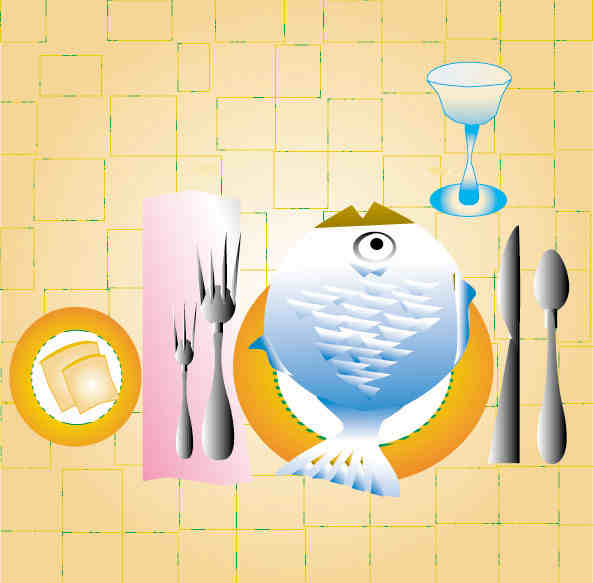2. USE YOUR UTENSILS CORRECTLY
OK, hot shot. You know where your stuff is. But now it's time to know how to use everything properly. Take your napkin and place it in your lap right away when you sit down. (It should never be on the table.) Don't get fancy and try to snap it open. Just put it on your lap (NOT into your shirt). If you're a man, do not put your tie over your shoulder.Now you can take some bread from the breadbasket. Take only one slice of bread. (It's OK to rip it from the loaf with your hands, but be neat. Don't declare war on the bread and cheer when you get your slice separated.) Here's a common mistake: DO NOT butter your bread at this point. Yeah, you heard us. This is how to do it:
- Take some butter, and put it on your plate, not on the bread. Now you have your own little pile of butter and won't continually fish from the communal butter dish.
- Tear a bite-size piece off of your bread.
- Butter that bite-sized piece from your own little butter pile.
- Eat it with delight.
The first part of the meal comes: the appetizers. But what utensil should you use? You can find the answer in…
GENERAL TIP #3: Use your utensils from the outside in
Here's a funky example of what the utensil layout in front of you may look like:

The fork furthest to the outside is the one you should use for the appetizer. When the next part of the meal comes, use the next outermost fork, and so on. Same deal goes for the spoons and knives. If you're in a fancy restaurant or a party at Buckingham Palace, you might be lucky enough to have waiters who will remove any utensils you won't need. But even if you do not have this luxury, we still implore: use your brains! You won't use a knife to eat your soup. You won't use a spoon to eat your salad. But let's say that you lose track of your utensils and get lost. Then, proceed to…
GENERAL TIP #4: If you're not sure what to do, wait and see what your neighbor does. If that offers no clue, then just fake it
Chances are, nobody's watching you closely enough to see that you're using your dinner fork instead of the salad fork (the salad fork is the smaller one). Don't draw attention to yourself. Don't make a big deal of it. Just take a guess and eat. If you used the wrong utensil, the waiter will bring you a replacement.
Here is the proper technique for using a fork and knife. Assuming you are right-handed, hold the fork in your left hand and knife in your right. With the tines facing downward (curving towards you), hold down an end-piece of whatever you are cutting (let's assume it's meat). Do not hold the knife or fork like a dagger, but rather, place your index finger along the top of each utensil, holding each at the end. This gives you greater control without looking like you're hacking into the poor dead animal. Gently, using a sawing motion, cut the meat near the tines of the fork, so that you have one bite-sized piece. Then, lay the knife down (without allowing it to touch the table), and switch the fork (complete with pierced meat) to your right hand. Bring it up to your mouth, chew quietly, and swallow when the meat is sufficiently masticated. This is called the American (or Zig-Zag) method of cutting food. The Continental (or European) method consists of not switching hands, and using the left hand for all fork-related activities.
Before we move on, remember the thing we said about not letting the knife touch the table? That's because…
GENERAL TIP #5: You should never let any utensils, once used, EVER touch the table again
This includes leaning a fork onto the plate, or using a knife and putting it back in its original place. The original reason is because the utensil could dirty the tablecloth (a major faux pas) and result in a cleaning bill for the host. So once a utensil is used, it's lifespan is over. Get over it, and leave it on the plate at all times.
One last note should be made about soup. Many people do not know how to correctly use a soup spoon, so we will supply you with…
GENERAL TIP #6: Do not put the entire soup spoon in your mouth
Instead, fill a soup spoon about 75% with soup, bring it up to your mouth, and sip it from the side with as little slurping as possible. When your soup runs low, it's acceptable to tip your bowl away from you so that you can capture the last bits of soup, but don't do that more than twice. And remember to lower your spoon into your soup gently so that it doesn't bang the bottom of the bowl. Imagine 20 people eating soup and banging their bowl bottoms.

